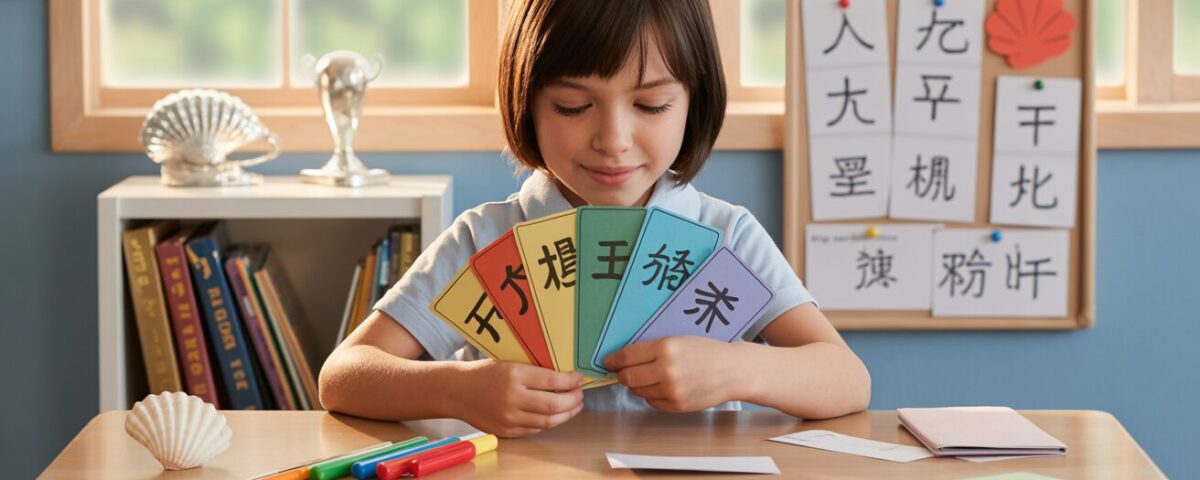
PSLE Prep Hack: Master 2000+ Chinese Words Easily With The Word Root Method
October 7, 2025
10 Fun Listening Comprehension Games for Primary 1-3 Students That Boost Language Skills
October 8, 2025Table Of Contents
- Understanding Chinese Word Roots and Their Importance
- Benefits of Using Word-Root Flashcards
- Materials Needed for DIY Flashcards
- Step-by-Step Tutorial for Creating Word-Root Flashcards
- Creative Ways to Use Your Word-Root Flashcards
- Digital Alternatives to Paper Flashcards
- How Seashell Academy’s Approach Enhances Vocabulary Learning
- Conclusion: Building a Foundation for Chinese Language Success
Learning Chinese characters can sometimes feel like navigating through an ocean of unfamiliar symbols for primary school students. The characters may appear disconnected and overwhelming at first glance, making vocabulary retention challenging. But what if there was a way to transform this seemingly endless memorization task into a structured, engaging learning experience?
Word-root flashcards offer exactly that solution. By focusing on the fundamental building blocks of Chinese characters, students can develop a deeper understanding of character formation and meaning, making vocabulary learning more systematic and enjoyable. At Seashell Academy by Suntown Education Centre, we’ve seen remarkable improvements in students’ Chinese vocabulary acquisition through our structured approach to learning character components.
This comprehensive tutorial will guide you through creating and using DIY word-root flashcards that align with our proven teaching methodologies. By the end, you’ll have a powerful tool to support your child’s Chinese language journey—one that transforms character memorization from a daunting task into an engaging exploration of language patterns. Let’s dive into how you can create these effective learning tools at home to complement classroom learning.
DIY Chinese Word-Root Flashcards
Transform Character Memorization Into Engaging Learning
Learn how to create effective Chinese word-root flashcards that boost vocabulary retention and make learning enjoyable for primary school students.
What Are Word Roots?
Word roots are the fundamental building blocks of Chinese characters that carry meaning. They transform disconnected symbols into a structured system that students can analyze and understand.
Key Benefits
- Facilitates pattern recognition
- Engages multiple learning modalities
- Transforms abstract concepts into tangible tools
- Builds confidence through incremental mastery
5-Step Flashcard Creation Process
Select Word Roots
Choose 20-30 common roots relevant to your child’s learning level
Design Flashcards
Create front (root, pinyin, meaning) and back (example characters)
Add Visual Cues
Include simple drawings that help remember meanings
Add Examples
Include characters that demonstrate how the root contributes to meaning
Organize System
Group by meaning or appearance using color-coding
Sample Word Root Card: 木 (mù)
PINYIN
mù
木
wood/tree
Example Characters:
- 林 (lín) – forest
- 森 (sēn) – dense forest
- 果 (guǒ) – fruit
- 桌 (zhuō) – table
Creative Usage Ideas
- Character Building Game: Combine roots to form complete characters
- Word Family Expansion: List characters containing the same root
- Story Creation: Create sentences using characters with selected roots
- Progressive Review System: Move cards between daily, weekly, and monthly review boxes
Materials Needed
Basic Materials:
- Index cards (3×5″ or A6)
- Colored markers/pens
- Scissors
- Hole punch (optional)
- Binding rings
- Laminating pouches (optional)
Reference Resources:
- List of common Chinese radicals
- Chinese dictionary
- Child’s current vocabulary list
Optional Enhancements:
- Colored card stock for categories
- Stickers for visual coding
- Storage container
- Tracing paper for practice
The Seashell Method Advantage
Our word-root flashcard system aligns with Seashell Academy’s holistic approach to Chinese language learning:
Structured Learning
Breaking complex language into manageable components
Mind-Mapping
Creating visual connections between concepts
Interactive Learning
Engaging activities that maintain interest while building skills
Sustainable Growth
Building long-term language foundation rather than short-term memorization
Created by Seashell Academy by Suntown Education Centre
Nurturing Primary School Success Through Holistic Learning
Understanding Chinese Word Roots and Their Importance
Chinese characters may appear complex at first glance, but they’re actually built from smaller components that carry meaning. These components, often called radicals or word roots, serve as the foundation of character formation. Understanding these building blocks is like discovering the DNA of the Chinese language.
Word roots typically fall into several categories: pictographs that resemble their meanings (like 山 for mountain), ideographs that represent abstract concepts, and compound ideographs that combine multiple elements to create meaning. When students learn to recognize these components, they gain the ability to decipher unfamiliar characters by analyzing their parts rather than memorizing each character as an isolated unit.
For primary school students, particularly those in Primary 4-6, developing this analytical approach to Chinese characters is crucial. At Seashell Academy’s P4 Chinese Programme, we emphasize this foundation because it transforms the learning process from mere memorization to genuine understanding. Students who recognize that 木 (wood) appears in characters like 林 (forest), 森 (dense forest), and 果 (fruit) develop cognitive connections that significantly enhance retention.
These word roots also provide cultural insights and historical context that deepen a student’s appreciation for the language. When children understand why characters are formed the way they are, they develop not just linguistic knowledge but cultural awareness as well.
Benefits of Using Word-Root Flashcards
Creating and using word-root flashcards offers numerous advantages that align perfectly with the holistic learning approach we champion at Seashell Academy by Suntown Education Centre:
First, these flashcards facilitate pattern recognition. Rather than memorizing hundreds of seemingly unrelated characters, students begin to recognize recurring elements and understand the logic behind character formation. This pattern recognition is particularly valuable for P5 Chinese students who face increasingly complex vocabulary requirements.
Second, the process engages multiple learning modalities. By physically creating the cards, visually processing the information, and verbally practicing the pronunciation, students activate different cognitive pathways that reinforce memory formation. This multi-sensory approach is central to our programme philosophy at Seashell Academy.
Third, word-root flashcards transform abstract concepts into tangible learning tools. When students can physically manipulate and organize these components, abstract linguistic principles become concrete and manageable. This is especially important for visual learners who benefit from spatial organization of information.
Finally, this approach builds confidence through incremental mastery. As students recognize more word roots, each new character becomes less intimidating. This growing confidence creates a positive feedback loop that nurtures the love for learning we strive to instill in all our students.
Materials Needed for DIY Flashcards
Creating effective word-root flashcards doesn’t require expensive materials. The focus should be on durability and usability. Here’s what you’ll need:
Basic Materials:
• Index cards (preferably 3×5 inches or A6 size) or card stock paper cut to size
• Colored markers or pens (including red, which is traditionally used for emphasis in Chinese learning)
• Scissors
• A hole punch (optional, for creating card rings)
• Binding rings or rubber bands (for organization)
• Clear contact paper or laminating pouches (optional, for durability)
Reference Resources:
• A list of common Chinese radicals and word roots (can be found in your child’s textbook or provided by their Chinese teacher at Seashell Academy)
• A Chinese dictionary or online resource that shows character decomposition
• Your child’s current vocabulary list from school
Optional Enhancements:
• Colored card stock for categorizing different types of word roots
• Stickers or colored dots for visual coding
• Small container or box for storage
• Tracing paper for practicing character writing
What makes these materials particularly effective is how they allow for personalization. At Seashell Academy, we’ve observed that students engage more deeply with learning tools they’ve helped create. The process of selecting colors, organizing categories, and designing their flashcards becomes part of the learning experience itself, creating emotional investment in the study materials.
Step-by-Step Tutorial for Creating Word-Root Flashcards
Step 1: Selecting Appropriate Word Roots
Begin by identifying the most relevant word roots for your child’s current learning level. For P6 Chinese students preparing for PSLE, focus on the high-frequency radicals that appear in examination vocabulary. For younger students, start with the basic pictographic elements that are visually intuitive.
We recommend starting with 20-30 common word roots such as:
• 木 (wood/tree)
• 氵 (water)
• 女 (woman/female)
• 心 (heart)
• 口 (mouth)
• 手/扌 (hand)
These components appear frequently across the primary school Chinese curriculum and provide an excellent foundation. Review your child’s textbook or consult with their teacher at Seashell Academy to identify which word roots would be most beneficial to focus on first.
Step 2: Designing Your Flashcards
Now it’s time to create the physical flashcards. For each word root, follow this format:
Front of card:
• Write the word root large and clear in the center
• Include its pronunciation (pinyin with tone marks) at the top
• Add the English meaning at the bottom
Back of card:
• List 3-5 common characters that contain this word root
• Include the pinyin and meaning of each character
• Draw a simple diagram showing where the root appears in each character (you can highlight or circle it)
For example, a flashcard for the root 木 (mù, wood) might list characters like 林 (lín, forest), 森 (sēn, dense forest), and 果 (guǒ, fruit) on the back, with the 木 component highlighted in each one.
At Seashell Academy, we emphasize clean, uncluttered designs that allow students to focus on the essential information. Too much visual information can overwhelm young learners, so aim for clarity and simplicity in your design.
Step 3: Creating Visual Connections
The power of word-root flashcards lies in making visual connections explicit. For each word root, add a simple drawing or symbol that helps your child remember its meaning. For instance, for 木 (wood), you might draw a simple tree; for 氵(water), a small wave.
This technique taps into the mind-mapping approach that forms part of our Seashell Method. By connecting abstract linguistic elements to concrete visual representations, students create stronger neural pathways for recall. These visual cues act as memory hooks that make recalling the meaning of unfamiliar characters much easier.
If your child is artistically inclined, involve them in creating these visual elements. The act of drawing reinforces the connection between the symbol and its meaning. If drawing isn’t your strong suit, even simple stick figures or abstract symbols can be effective memory aids.
Step 4: Adding Example Words
For each word root, carefully select example characters that clearly demonstrate how the root contributes to overall character meaning. Ideally, these examples should come from vocabulary your child is currently learning in school or will encounter soon in their primary school curriculum.
For each example character on the back of the card:
• Write the complete character
• Highlight or color the word root within it
• Include the pinyin pronunciation with tone marks
• Add the English meaning
• If possible, include a brief note on how the root contributes to the character’s meaning
For example, on the card for 女 (nǚ, woman), you might include the character 妈 (mā, mother) and note that “This character combines the woman radical with the phonetic component 马 (mǎ), creating a character that means ‘mother’.”
This approach aligns with our focus on meaningful learning rather than rote memorization at Seashell Academy. By understanding the logic behind character formation, students develop the analytical skills needed for independent language learning.
Step 5: Organizing Your Flashcard System
Organization is key to making your flashcard system effective. We recommend dividing your flashcards into logical categories based on either meaning or appearance:
Meaning-based categories might include:
• Nature elements (water, fire, wood, etc.)
• Body parts (hand, mouth, heart, etc.)
• People and relationships (woman, child, etc.)
• Actions and movements
Appearance-based categories might organize by:
• Number of strokes
• Position within characters (left-side radicals, top radicals, etc.)
• Frequency of appearance in your child’s current vocabulary lists
Use different colored cards or colored dots to visually code these categories. This organizational approach mirrors our structured learning plans at Seashell Academy, where we create clear frameworks that help students manage information efficiently without feeling overwhelmed.
Store your completed flashcards in a dedicated container, organized by categories. Consider using dividers or separate rings for different groups. This systematic organization makes review sessions more efficient and helps students see the relationships between different word roots.
Creative Ways to Use Your Word-Root Flashcards
Creating flashcards is only the beginning—how you use them determines their effectiveness. At Seashell Academy, we believe that learning should be engaging and interactive. Here are several techniques to maximize the impact of your word-root flashcards:
1. The Character Building Game
Spread several word-root cards face-up. Challenge your child to combine two or more roots to form complete characters they know. For instance, combining the cards for 木 (wood) and 目 (eye) might lead them to create the character 相 (xiāng, mutual). This game develops an understanding of character composition while making learning playful.
2. Word Family Expansion
Select one word-root card and challenge your child to brainstorm as many characters containing that root as they can within one minute. Write these down and discuss how the root contributes to each character’s meaning. This activity builds fluency and reinforces the connectedness of Chinese vocabulary.
3. Story Creation
Select 3-5 random word-root cards and challenge your child to create a short story or sentence using characters that contain these roots. This exercise connects vocabulary learning to creative expression and practical language use, mirroring our emphasis on real-life application of knowledge at Seashell Academy.
4. Progressive Review System
Implement a spaced repetition approach where cards move between three boxes: daily review, weekly review, and monthly review. As your child masters certain word roots, they progress to less frequent review schedules, optimizing study efficiency. This system reflects our focus on sustainable learning rather than cramming.
These interactive approaches transform flashcards from static review tools into dynamic learning experiences. They incorporate the gamified elements that make our interactive lessons at Seashell Academy so effective, creating an environment where learning feels like discovery rather than work.
Digital Alternatives to Paper Flashcards
While physical flashcards offer tactile benefits that enhance learning, digital alternatives can provide additional features that complement traditional methods. For families embracing technology as a learning tool, consider these digital options:
1. Flashcard Apps
Apps like Quizlet, Anki, or Pleco allow you to create digital flashcard sets with audio pronunciation, stroke order animations, and spaced repetition algorithms. These features can be particularly helpful for auditory learners who benefit from hearing correct pronunciations.
2. Interactive Character Learning Tools
Websites and apps specifically designed for Chinese character learning often include radical breakdowns and etymology explanations that deepen understanding of word roots. Many offer game-based practice that maintains engagement while reinforcing learning.
3. Creating Digital Mind Maps
Digital mind-mapping tools allow students to create visual networks connecting word roots to their derived characters. These expandable visual representations can grow alongside your child’s vocabulary, creating a comprehensive visual dictionary organized by components.
At Seashell Academy, we recognize that technology can be a powerful supplement to traditional learning methods when used purposefully. The ideal approach often combines digital and physical tools to engage different learning modalities and maintain flexibility in learning environments.
That said, we recommend balancing screen-based learning with physical flashcard activities, particularly for younger students. The kinesthetic aspect of handling physical cards and the cognitive benefits of handwriting characters remain valuable components of effective language acquisition.
How Seashell Academy’s Approach Enhances Vocabulary Learning
The DIY word-root flashcard system outlined in this tutorial embodies many of the core principles that make Seashell Academy by Suntown Education Centre’s approach to Chinese language learning so effective.
Our Seashell Method incorporates structured learning plans that break down complex language elements into manageable components—just as these flashcards organize characters by their constituent parts. This systematic approach prevents overwhelm and builds confidence through incremental mastery.
The visual connections emphasized in the flashcard design reflect our mind-mapping approach to learning, which helps students see relationships between concepts rather than memorizing isolated facts. This creates the cognitive frameworks necessary for long-term retention and application.
The interactive learning activities suggested for using these flashcards mirror our gamified, interactive lessons that maintain engagement while building skills. We understand that learning happens most effectively when students are actively involved and emotionally invested in the process.
Most importantly, this flashcard system supports our commitment to sustainable growth rather than burnout. By transforming character learning from an overwhelming memorization task into a structured, manageable process of discovery, we help students develop genuine interest and confidence in their Chinese language abilities.
In our Programme Philosophy, we emphasize that true mastery comes not just from knowing information, but from understanding how language works and developing the confidence to use it. Word-root flashcards support exactly this kind of deep, conceptual understanding that extends far beyond examination preparation.
Conclusion: Building a Foundation for Chinese Language Success
Creating and using DIY word-root flashcards represents more than just an effective study technique—it embodies a thoughtful approach to language learning that aligns with how the brain naturally acquires and organizes information. By breaking down Chinese characters into their fundamental components, you’re helping your child develop analytical skills that will serve them throughout their language learning journey.
The process of creating these flashcards involves both parent and child in the learning process, fostering the kind of supportive learning environment we value at Seashell Academy. As your child progressively masters more word roots, they’ll experience growing confidence in their ability to decipher new characters independently—a skill that extends far beyond primary school examinations.
Remember that consistency is key. Short, regular review sessions using these flashcards will yield better results than occasional marathon study sessions. This sustainable approach to learning prevents burnout and cultivates genuine interest in the Chinese language.
At Seashell Academy by Suntown Education Centre, we’ve seen how this structured approach to vocabulary building transforms students’ relationship with Chinese language learning. What begins as a challenging memorization task becomes an engaging exploration of patterns and connections, nurturing not just academic success but a genuine love for learning.
We encourage you to try this flashcard system at home as a complement to your child’s formal Chinese instruction. As with any learning tool, feel free to adapt and personalize it to suit your child’s specific learning style and needs. The most effective educational approaches are those that recognize and respond to each learner’s unique characteristics.
Need Expert Guidance for Your Child’s Chinese Language Journey?
If you’d like personalized support in implementing these flashcard techniques or exploring other effective Chinese language learning strategies, our experienced MOE-trained educators at Seashell Academy are here to help.
Our small class sizes ensure each student receives the individualized attention they need to thrive, while our holistic approach nurtures both academic excellence and emotional well-being.
Contact us today to learn more about our Primary Chinese programmes and how we can support your child’s language learning success.





